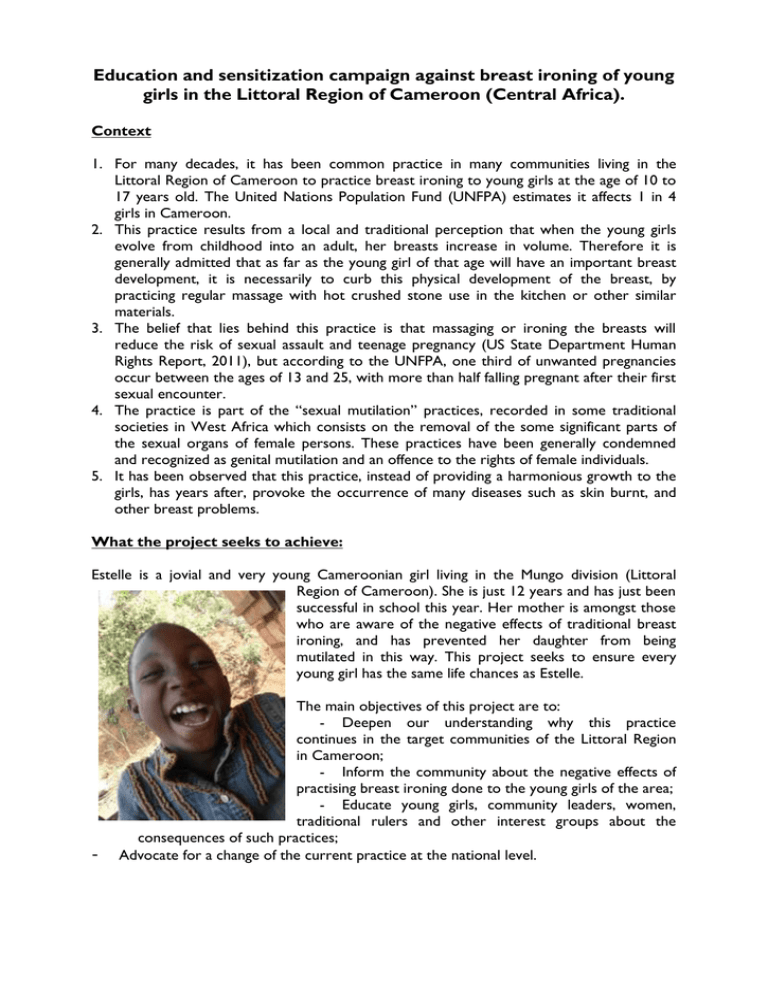
Education and sensitization campaign against breast ironing of young
girls in the Littoral Region of Cameroon (Central Africa).
Context
1. For many decades, it has been common practice in many communities living in the
Littoral Region of Cameroon to practice breast ironing to young girls at the age of 10 to
17 years old. The United Nations Population Fund (UNFPA) estimates it affects 1 in 4
girls in Cameroon.
2. This practice results from a local and traditional perception that when the young girls
evolve from childhood into an adult, her breasts increase in volume. Therefore it is
generally admitted that as far as the young girl of that age will have an important breast
development, it is necessarily to curb this physical development of the breast, by
practicing regular massage with hot crushed stone use in the kitchen or other similar
materials.
3. The belief that lies behind this practice is that massaging or ironing the breasts will
reduce the risk of sexual assault and teenage pregnancy (US State Department Human
Rights Report, 2011), but according to the UNFPA, one third of unwanted pregnancies
occur between the ages of 13 and 25, with more than half falling pregnant after their first
sexual encounter.
4. The practice is part of the “sexual mutilation” practices, recorded in some traditional
societies in West Africa which consists on the removal of the some significant parts of
the sexual organs of female persons. These practices have been generally condemned
and recognized as genital mutilation and an offence to the rights of female individuals.
5. It has been observed that this practice, instead of providing a harmonious growth to the
girls, has years after, provoke the occurrence of many diseases such as skin burnt, and
other breast problems.
What the project seeks to achieve:
Estelle is a jovial and very young Cameroonian girl living in the Mungo division (Littoral
Region of Cameroon). She is just 12 years and has just been
successful in school this year. Her mother is amongst those
who are aware of the negative effects of traditional breast
ironing, and has prevented her daughter from being
mutilated in this way. This project seeks to ensure every
young girl has the same life chances as Estelle.
-
The main objectives of this project are to:
- Deepen our understanding why this practice
continues in the target communities of the Littoral Region
in Cameroon;
- Inform the community about the negative effects of
practising breast ironing done to the young girls of the area;
- Educate young girls, community leaders, women,
traditional rulers and other interest groups about the
consequences of such practices;
Advocate for a change of the current practice at the national level.
The beneficiaries
Beneficiaries of the project are:
a) 500 young girls of the project area, aged between 10 to 17 years old and potential
victims of this harmful traditional practice;
b) Female elders (mothers, aunts, grandmothers, etc) who are the parents and traditional
practitioners;
c) The Loum community (c.150,000 people) including local traditional leaders, health
authority, schools, parents, etc. all of whom have an interest in ending this practice.
Activities
Five main activities are targeted for this project:
a- Participatory survey and knowledge sharing on the motivation and how the practice is
undertaken;
b- Creation of a documentary on the situation faced by young girls and testimonies from
the victims, which can be used to disseminate information and key messages;
c- Clinical support from a psychologist to help 150 affected girls;
d- Organization of a Workshop to inform, sensitize and educate 50 people drawn from
various stakeholders (including 10 from outside the region) involved in the breast ironing
practice as well as health authorities, traditional rulers and local authorities about the
practices, it impacts, etc…
e- Advocacy activities at the national level targeting policymakers and other various
stakeholders – including collaborative activities with other NGOs and CBOs active on
these issues.
Budget
Items
Participatory survey
Survey (honorarium and expenses)
Background research
Sub total 1
Realisation of the documentary
Honorarium for cameraman and other field
expenses
Sub total 2
Clinical support
This clinical support will be undertaken by
physician working in public hospitals a
number of 150 girls at this pilot phase.
Sub total 3
Transport, lodging, food and incidentals
Reimbursement transport fees for outside
participants
Lodging for outside participants
Food and incidentals (for outside
participants)
Lunch and tea for workshop participants (50
lunchX2 days)
unit
Unit cost
(£)
Total (£)
1
1
410.5
100
410.5
100
£510.50
1
1200
1200
£1,200
150
5
750
£750
10
12.15
121.5
10
10
9.5
10
95
100
50
14
700
Sub Total 4
Logistics for the meeting
Venue hire
Equipment hire
Workshop facilitation
Workshop materials (pen, files, writing pad,
etc)
Workshop banner
Sub total 5
Follow up activities
Compilation of participatory survey and
workshop reports
Printing of overview reports in French and
English
Report distribution and advocacy activities
Sub total 6
TOTAL 1+2+3+4+5+6
Unforeseen (5%)
GRAND TOTAL
£1,016.5
2
2
2
50
36.5
31
61
1.25
73
62
122
62.5
1
31
31
£350.5
1
100
100
500
1.5
750
250
250
£1,100
£4,927.5
£246.3
£5,173.8








